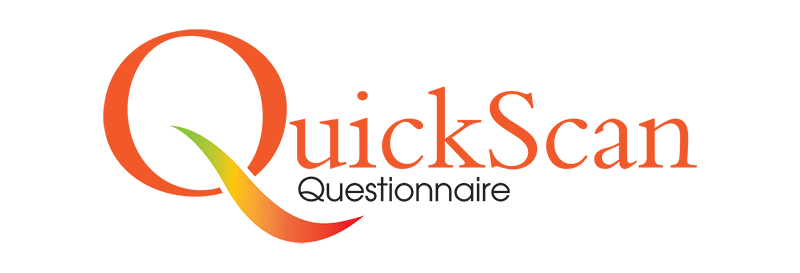
QuickScan Dyslexia Questionnaire (aged 14+)
QuickScan is a long established online questionnaire designed to identify indicators of dyslexia. The report it produces also considers indicators of dyspraxia, dyscalculia, visual stress, general difficulties with study and literacy, and any lack of fluency in English language.

The QuickScan Questionnaire is well respected across London and the UK. It’s used in Ireland, Scotland, Wales, Northern Ireland, England, Australia, New Zealand, USA and Canada. All that is required is a working knowledge of spoken and/or written English.
QuickScan can be completed by anyone age 14+ with a basic level of proficiency in English for £14.50 (incl VAT). You’ll be able to gain insights into your overall mode of learning as well as your learning differences.
Already paid for QuickScan?
• If you paid for a QuickScan-OnLine Session but did not complete it straight away, please click here to go to a page where you just need to enter your email and passcode, then click the “Start” button.
• If you completed QuickScan-OnLine earlier and want to to retrieve your report online, then please click on the QuickScan-OnLine Start Page.
An introduction to QuickScan – helping to identify dyslexia in young people and adults
The QuickScan dyslexia questionnaire is intended to take a diagnostic look at the way you work, your strengths and weaknesses and your preferred mode of learning.
This questionnaire is designed to help recognise dyslexia in young people and adults at college/university or in their workplace. It provides valuable information about your learning abilities and possible learning differences that might require support.
Thank you for the reports. It matches very well with my own perceptions. In fact, I hadn’t done the questionnaire before, and found it very useful and fun to do. In the light of the recommendations, I will adjust my note-taking and method of studying languages, using coloured cards, and using a wider range of media.
Secondary School Teacher
Why choose the online QuickScan Dyslexia questionnaire?
- It is appropriate for those aged 14+ with no upper limit
- Only takes, on average, about 10-15 minutes
- You can complete the test immediately upon purchase, or choose to complete it at a later time
- Simple to use on all desktops, laptops and larger tablets but NOT on mobile phones
- Please disable pop-up blockers
- At the end of the test you will receive a report showing your preferred mode of learning, any need for study skills, maths or language support, indications of dyslexia, dyspraxia, along with any signs of visual stress
- Your report is emailed to you, but is also be available to view online or download once you have finished the questionnaire
- Is very affordable at just £14.50 (including VAT)
You can read more information in our FAQ section at the bottom of this page
How to register and complete your QuickScan test
Read our step-by-step guide for registering for a QuickScan test, completing your test (now or later) and retrieving your report.
About Quickscan and Additional Support
Generally, QuickScan is estimated to show between 90-95% accuracy in its reports, and this is in line with the Adult Dyslexia Checklist.
It has been used for many years to provide a valuable starting point for personal learning support needs or to look at introducing reasonable adjustments in the workplace.
As well as dyslexia it looks at many other differences in learning. It also provides an indication of your current preferred learning mode, which can be seen as a starting point in exploring and better understanding of multisensory learning.
You are welcome to email any questions you may have to the QuickScan dyslexia test team on [email protected], or use the form on our contact page.
It is also possible to speak to our enquiries manager on the phone. She will either assist you directly or put you in contact with someone who can.
Please call 020 8674 9571 between 9 am – 5 pm, Monday to Friday. If you leave a message – please clearly state your name and return contact details. We do our best to return your call within 24 hours.
Frequently Asked Questions (FAQs)
Here are some of our Frequently Asked Questions (FAQs) about dyslexia testing…
Q. How does it work?
QuickScan is a questionnaire-based program which asks you a number of questions relating to a wide range of study related topics.
You will be asked to give yes/no answers as you work through the program and at the end a report is produced based on a detailed matrix which filters all the answers according to a range of factors.
Q. What will QuickScan identify?
Apart from indications of dyslexia, QuickScan looks for signs of a wide range of possible issues including a need for study support, maths upgrading, language support, learning confidence, fine motor dyspraxia and potential visual stress.
Q. What happens if I close the webpage after making a purchase?
If you completed your PayPal purchase but did not return to the Start page for any reason, please contact us for a new QuickScan passcode.
If you returned to the Start Page but didn’t start the program for any reason, you should find that you will have been sent your passcode by email. If not then please contact us, otherwise return to the start page and enter your email and passcode to start your session.
Q. Over the years I have found my own strategies for learning. Will QuickScan still identify my dyslexia?
QuickScan can only report on the answers you give it. In general though, if you answer the questions honestly it has proved to be accurate at identifying issues that are still affecting your performance.
However, it is occasionally possible that it may not identify your dyslexia if you have successfully overcome many of your earlier difficulties.
Q. What are learning modes ?
We all absorb information through our senses and for people with dyslexia some of the filters through which learning is assimilated are erratic and may take longer to process incoming data.
It may well be useful to find out which learning modality you using predominantly at the present time. Since multi-sensory learning has always been accepted as the best way to acquire and retain information, then the chosen current preferred mode of learning can be seen as a starting point towards a better understanding and development of a more integrated approach.
Q. Can QuickScan identify maths problems?
QuickScan asks a number of numeracy related questions and will report if there is a possibility that maths performance may also have been adversely affected.
Q. Can QuickScan identify Dyspraxia?
There is quite an overlap between dyslexia and dyspraxia and this is reflected in the questionnaire.
However, QuickScan specifically focuses on fine motor skills (i.e. handwriting skills) and since it is not an exhaustive list of dyspraxia characteristics, gross motor function is beyond the scope of this questionnaire and would need to be checked separately.
Q. What does the report contain?
Your report will contain information relating to your current preferred learning mode – and you can use this as a starting point towards a more integrated method of learning. It will show if you present with any indicators of dyslexia, fine motor dyspraxia (problems with handwriting), numeracy issues, possible need for study and language support as well as any signs of visual stress.
Q. English is not my first language - Can I still use QuickScan?
As long as you are able to understand and respond to the questions QuickScan will be able to produce a report.
Questions are available in audio as well, which may help with understanding them more easily.
QuickScan will also usually identify cases where English is not the first language.
Q. I am partially sighted can I still use QuickScan?
QuickScan is designed to be accessible for partially sighted and blind users. It has full audio delivery for the questions and has keyboard operation available using the known “home” keys and the spacebar.
Q. How long does it take to complete QuickScan?
QuickScan should be completed in a single sitting and usually takes around 10-15 minutes. If it takes significantly longer than that, this may be an indication of literacy issues or speed of processing difficulties. Neither of these issues alone is conclusive indication of dyslexia but they may well be contributing factors.
Q: what is visual stress and does QuickScan identify it?
You can select the background colour that best suits you as well as the size of font when you start doing the questionnaire.
There are a number of visual issues that may affect reading fluency ( basic visual short and long sightedness need to be ruled out as a first step) but they could also be related to visual stress which is an over sensitivity to the contrast between the font colour and the background colour.
Black printed text on white paper is one of the more problematic combinations for a person with visual stress, and sometimes the use of coloured overlays or a change of screen colour on computer screens can make a huge difference. Eye strain and headaches reportedly have been reduced and reading fluency improved.
Q. Is QuickScan accepted for special arrangements?
QuickScan is not accepted on its own for exam boards or by funding bodies, but it does offer a starting point for identifying individual needs.
If there are any indicators of dyslexia, we recommend that you use the QuickScreen program to explore these further and put together relevant background information to present to your support team.
If you are under 17 years of age and cannot use QuickScreen we make other recommendations. Many organisations and workplaces do, however, use QuickScan as a starting point for putting “reasonable adjustments” in place.
Q. Learning styles were very much talked about and now seem to have been rather discredited - what is your opinion?
The whole issue appears to have been swept aside by some academics as it was clearly an over simplification of how we learn. That we would agree with, but debunking the whole concept is open to discussion. They understandably concluded that trying to base classroom teaching on individual learning styles preferences did not have the desired benefits for pupils by way of measurable improved outcomes.
We acknowledge that our method of absorbing information from around us is far more complex and multi faceted than would appear from those basic categories.
Research shows that among people with dyslexia their intake of information through the senses is not uniform and can lead to difficulties. There is a greater overlap between the modes of learning and there are further fluctuations in how we perceive and assimilate information once it has been internalized that suggest this to be quite subjective and therefore difficult to define.
The link here is a video discussion that people with dyslexia might find very illuminating as it touches on some of these complexities.
However, the main teaching approach within the dyslexia field of making information as multi-sensory as possible has a well established foundation and, in our view, an understanding of the different learning modalities offers some useful insights to the learner rather than imposing limitations. A better level of self awareness as to how we learn is a useful tool.